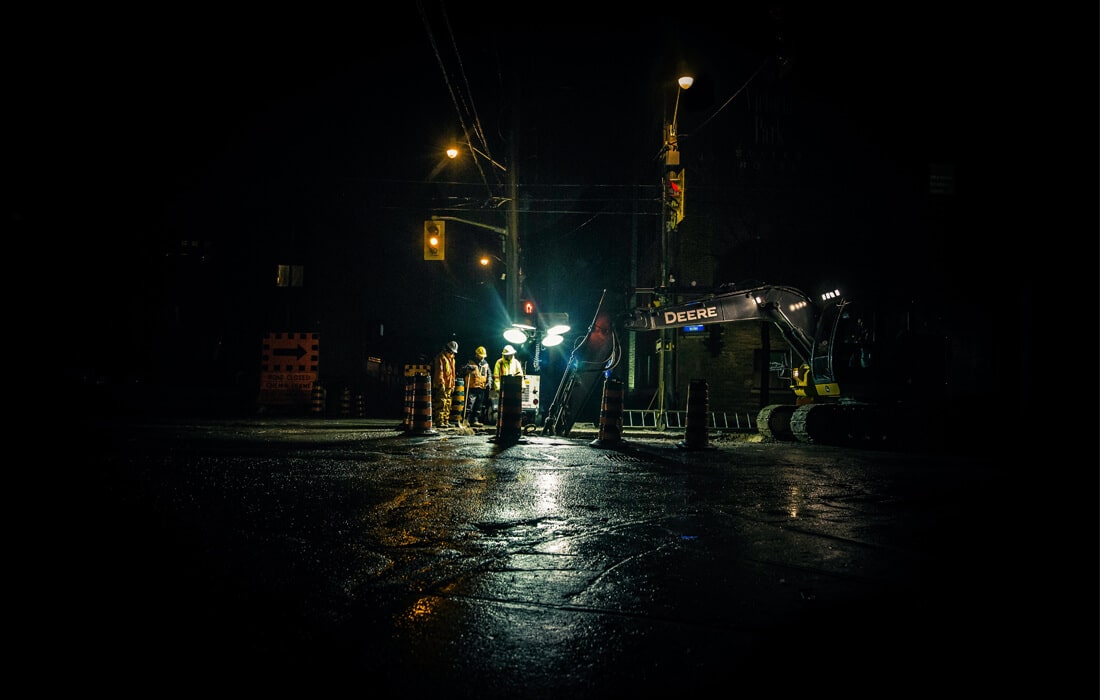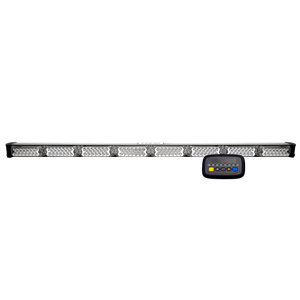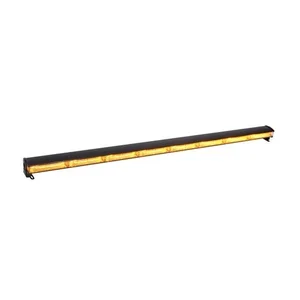Working safely alongside public roads is of paramount importance to ensure traffic safety. If you are a road builder, asphalt worker, cable installer, or road cleaner, it's essential to be familiar with the regulations that apply when working safely alongside the road. In this blog, we will guide you through the options for road closure and the rules that apply in these situations.

Risks when working at the roadside
Work on and near the road comes with its own set of risks. Therefore, it's of paramount importance to remain vigilant regarding your own safety, that of your colleagues, and maintaining order on the public road. Working safely alongside the road involves various responsibilities. It's wise to prepare thoroughly.
If you want to work safely along public roads, it is good to think of the following items at least:
- Traffic cone
- Guide Beacons/Shields
- Action window
- Collision absorber
- Warning beacon
- Signal clothing
Working along public roads with traffic cones
A good way to cordon off the road is by using traffic cones. By using these cones, you can easily close off a portion of the road, allowing you to work undisturbed on your tasks.
When using traffic cones, it is important that these cones are at least 0.75 m high and of fluorescent colour. In addition, the cone must, as the name suggests, be cone-shaped. The base plate must be square, so that it cannot roll over if it falls over. For this reason, the base plate has a minimum of 4 and a maximum of 8 sides.

Working safely alongside the road with guide beacons/signs
Another method of cordoning off the road is the use of guide posts or shields. These guide beacons are on average 1.40 m high. The beacons have diagonal (guiding) red/white stripes. These instruct road users on which side they should pass the beacons.
In addition, the guide beacons shall comply with the following requirements:
- The height of the plane with the red and white stripes is 1m;
- The height under the plane with the red and white stripes is <0.25m;
- The width of the area with red and white stripes is 0.25 meters.
- The width of the foot space is <0.50m.

Working safely along public roads with action frames
In the case of action frameworks, we distinguish three variants: a small action framework with one traffic sign on the work vehicle, a large action framework with two traffic signs on an action vehicle, and an action framework with two traffic signs on the work vehicle. Below, we will explain the various implementations of action frameworks and the corresponding rules.
Small action window with one traffic sign on the work vehicle
A small action framework with one traffic sign on the work vehicle serves as a "starting point" for short-term activities, such as roadside mowing. This variant of the action framework may only be used for work conducted alongside the road and on bicycle paths. In some cases, however, it may be used on very quiet roads with low speed limits and low traffic intensity, for example, on "true 60 km/h" roads.
A small action window with one traffic sign has the following characteristics:
- The width of the board with the white and red reflective material is 0.20m;
- The traffic sign determines the height and width. This means that for a type 2
traffic sign the dimensions are 1.30 m x 1.30 m; - The action window can be equipped with the traffic sign J16 or D02;
- The distance from the bottom of the traffic sign J16 to the ground must be at least 1.20
m and a maximum of 3 m. The distance from the bottom of the action window to the ground is
thus a minimum of 1 metre.
Please note that in the case of a small action frame with one traffic sign, if the yellow LED beacon on the vehicle is clearly visible, the LED flashers on the action frame are not necessary. However, when you want to work safely on the road, this is recommended. When flashers are placed on the action frame, they have to be placed on the quadrangles, be round, have a minimum diameter of 180mm and a maximum diameter of 200mm. They must also have a yellow colour.

Large action window with two traffic signs on an action trolley
In contrast to the small framework, the large action framework serves as the starting point for a moving road closure on busy roads within urban areas and on roads outside urban areas with a maximum speed limit of 80 km/h. Regarding the placement of a large action framework, it is theoretically possible to install it on the back of the vehicle. However, in practice, due to its dimensions, this is almost never feasible. Therefore, in many cases, we see a large action framework with LED flashlights mounted on a trailer.
The large action frame has the following characteristics:
- The width of the boards is 0.30m;
- the height is 3.30m and the width is 1.70m;
- May only be placed in the longitudinal direction;
- Four round yellow alternating lights with a minimum diameter of 180 mm and a maximum diameter of 300 mm shall be mounted on the action window;
- The distance from the bottom of the sign to the road surface must be at least 1.20 m;
- The vehicle must also have a yellow flashing light.
Action frame with two traffic signs on the work vehicle
The third method to close off the road using an action framework is through an action framework with two traffic signs on the work vehicle. Under certain conditions, an action framework can be placed on the work vehicle. The criteria that apply in this case are the same as the conditions for using an action framework on a vehicle, with the only difference being that the dimensions must be smaller than 2.00m x 1.30m, and the board width is 0.20m. The framework can be mounted both horizontally and vertically on the vehicle. This application is only allowed on roads designated as red and blue roads in the road layout.
On the orange roads outside urban areas, it is always mandatory to use a large action framework. This is necessary due to the high speed and traffic density on these roads. It is allowed to attach this action framework to a tractor, although this method of placement is often difficult to implement in practice. It is not possible to simultaneously connect another form of trailer to the tractor, which can make the execution of work more challenging.
Transporting action frames
Please note that when driving to your destination under normal road conditions, the action framework must not be visible on the vehicle. They should only be visible during temporary work.
Veilig werken langs de weg met LED Traffic Advisors van TRALERT®
Working safely along public roads with an (orange) LED flashing light
Another effective way to alert other road users is by using a rotating beacon light. Install a rotating beacon light on a vehicle in a moving road closure or when the vehicle may pose a potential hazard. This applies to agricultural tractors carrying a load. If the agricultural vehicle exceeds a width of 2.6 meters, it is mandatory to mount an Amber LED rotating beacon light on your vehicle.
Another situation where a rotating beacon light can be used is when a vehicle is parked in a potentially hazardous manner. In this case, you can use the rotating beacon light (or even a rotating beacon light bar) to warn passing traffic, especially in emergency situations. A prime example of this is the use of the rotating beacon light on an ANWB (Dutch Roadside Assistance) vehicle when responding to a breakdown on the highway.
The requirements for an LED beacon are:
- The flashing light must be amber;
- The flashing light must be clearly visible from all sides of the vehicle, so that road users from all directions can see the flashing light from a distance;
- When using LED beacons, the use of "electron torch" is not recommended. A flashing light is better when used. It allows the road user to better estimate the distance to the vehicle and the moving barrier;
- The flashing light may not be placed higher than the maximum height of a vehicle, as prescribed in the Vehicle Regulations. According to the legal regulations, this is 4 metres.

Working safely along public roads with signal clothing
"If you carefully follow the above rules, you're on your way to a well-lit workplace. The only aspect that's not well-lit is yourself. If you want to work safely along the road, it's also highly recommended to wear high-visibility clothing. This clothing ensures that you are easily visible too. As you can imagine, your main focus will be on carrying out your tasks, which may lead to less attention towards approaching traffic. By being highly visible along the road, drivers will notice you earlier and understand that you are part of the road closure.
Product requirements for signal clothing
High-visibility clothing must comply with the NEN-EN 471 standard. According to this standard, high-visibility clothing must always be made of retro-reflective and fluorescent materials. These materials are prescribed because they ensure good visibility both during the day and at night. Fluorescent materials stand out in daylight, while the retro-reflective bands provide good light reflection when a vehicle's headlight shines on them.

Safe roadside work begins at TRALERT®
At TRALERT®, road safety is of paramount importance to us. We strive daily to provide our partners with the brightest lighting, enabling them to carry out their work under optimal conditions. Our range includes high-quality LED lighting for various types of vehicles. For the aforementioned forms of road marking, TRALERT® offers a wide range of LED flashers, LED beacons, and LED emergency light bars. Curious about what else the TRALERT® range can offer you? Feel free to browse the entire selection on the TRALERT® dealer portal.
Perhaps also interesting: what is the maximum width of a trailer




